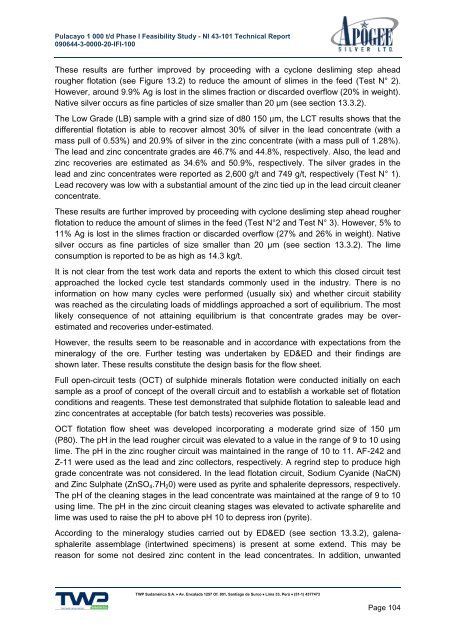Pulacayo Project Feasibility Study - Apogee Silver
Pulacayo Project Feasibility Study - Apogee Silver
Pulacayo Project Feasibility Study - Apogee Silver
You also want an ePaper? Increase the reach of your titles
YUMPU automatically turns print PDFs into web optimized ePapers that Google loves.
<strong>Pulacayo</strong> 1 000 t/d Phase I <strong>Feasibility</strong> <strong>Study</strong> - NI 43-101 Technical Report<br />
090644-3-0000-20-IFI-100<br />
These results are further improved by proceeding with a cyclone desliming step ahead<br />
rougher flotation (see Figure 13.2) to reduce the amount of slimes in the feed (Test N° 2).<br />
However, around 9.9% Ag is lost in the slimes fraction or discarded overflow (20% in weight).<br />
Native silver occurs as fine particles of size smaller than 20 µm (see section 13.3.2).<br />
The Low Grade (LB) sample with a grind size of d80 150 µm, the LCT results shows that the<br />
differential flotation is able to recover almost 30% of silver in the lead concentrate (with a<br />
mass pull of 0.53%) and 20.9% of silver in the zinc concentrate (with a mass pull of 1.28%).<br />
The lead and zinc concentrate grades are 46.7% and 44.8%, respectively. Also, the lead and<br />
zinc recoveries are estimated as 34.6% and 50.9%, respectively. The silver grades in the<br />
lead and zinc concentrates were reported as 2,600 g/t and 749 g/t, respectively (Test N° 1).<br />
Lead recovery was low with a substantial amount of the zinc tied up in the lead circuit cleaner<br />
concentrate.<br />
These results are further improved by proceeding with cyclone desliming step ahead rougher<br />
flotation to reduce the amount of slimes in the feed (Test N°2 and Test N° 3). However, 5% to<br />
11% Ag is lost in the slimes fraction or discarded overflow (27% and 26% in weight). Native<br />
silver occurs as fine particles of size smaller than 20 µm (see section 13.3.2). The lime<br />
consumption is reported to be as high as 14.3 kg/t.<br />
It is not clear from the test work data and reports the extent to which this closed circuit test<br />
approached the locked cycle test standards commonly used in the industry. There is no<br />
information on how many cycles were performed (usually six) and whether circuit stability<br />
was reached as the circulating loads of middlings approached a sort of equilibrium. The most<br />
likely consequence of not attaining equilibrium is that concentrate grades may be overestimated<br />
and recoveries under-estimated.<br />
However, the results seem to be reasonable and in accordance with expectations from the<br />
mineralogy of the ore. Further testing was undertaken by ED&ED and their findings are<br />
shown later. These results constitute the design basis for the flow sheet.<br />
Full open-circuit tests (OCT) of sulphide minerals flotation were conducted initially on each<br />
sample as a proof of concept of the overall circuit and to establish a workable set of flotation<br />
conditions and reagents. These test demonstrated that sulphide flotation to saleable lead and<br />
zinc concentrates at acceptable (for batch tests) recoveries was possible.<br />
OCT flotation flow sheet was developed incorporating a moderate grind size of 150 µm<br />
(P80). The pH in the lead rougher circuit was elevated to a value in the range of 9 to 10 using<br />
lime. The pH in the zinc rougher circuit was maintained in the range of 10 to 11. AF-242 and<br />
Z-11 were used as the lead and zinc collectors, respectively. A regrind step to produce high<br />
grade concentrate was not considered. In the lead flotation circuit, Sodium Cyanide (NaCN)<br />
and Zinc Sulphate (ZnSO 4 .7H 2 0) were used as pyrite and sphalerite depressors, respectively.<br />
The pH of the cleaning stages in the lead concentrate was maintained at the range of 9 to 10<br />
using lime. The pH in the zinc circuit cleaning stages was elevated to activate spharelite and<br />
lime was used to raise the pH to above pH 10 to depress iron (pyrite).<br />
According to the mineralogy studies carried out by ED&ED (see section 13.3.2), galenasphalerite<br />
assemblage (intertwined specimens) is present at some extend. This may be<br />
reason for some not desired zinc content in the lead concentrates. In addition, unwanted<br />
TWP Sudamérica S.A. Av. Encalada 1257 Of. 801, Santiago de Surco Lima 33, Perú (51-1) 4377473<br />
Page 104



